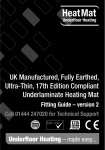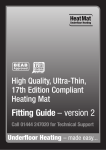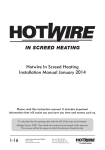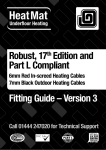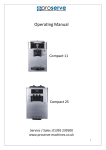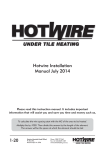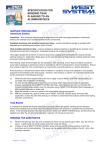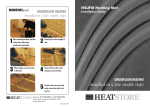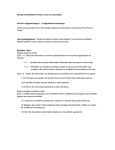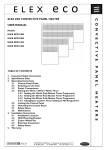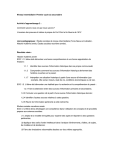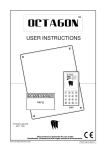Download Fitting Guide – version 1
Transcript
UK Manufactured, Fully Earthed, Ultra-Thin, 17th Edition Compliant Underlaminate Heating Mat Fitting Guide – version 1 Call 01444 247020 for Technical Support Underfloor Heating – made easy... Please ensure you read this guide completely before commencing installation of the underfloor heating. If you are unsure of any aspect of the installation please call Heat Mat’s Technical Support helpline on 01444 247020. Contents Do’s and Don’ts Technical information System and testing information Basic wiring diagram Combination & Positioning Installation instructions Warranty information 3 4 4 5 6 7 11 Before commencing your installation, please check that you have the correct heater or combination of heaters for your chosen area. (see page 6 for details) Heat Mat Limited accept no liability, either express or implied, for any consequential losses incurred as a result of a Heat Mat system installation that does not conform to the following installation instructions. 2 Please visit our website www.heatmat.co.uk for further information. Do’s and Don’ts • Do thoroughly read this guide before commencing installation • Do ensure the system is protected by a suitable dedicated RCD (30mA) • Do space the heaters evenly across the floor to produce a uniform heat output • Do log on to www.heatmat.co.uk to ensure you are using the most recent instructions • Do ensure that all green heating wire (including black joins) is covered with the aluminium foil or aluminium tape • Don’t cut, shorten, strain or cross the heating cables • Do ensure that all green heating wire (including black joins) is fitted beneath the floor covering • Do ensure your floor base has no sharp debris or objects such as nail heads protruding before beginning your installation • Do install the Underlaminate System beneath floating laminate floors and engineered board • Don’t bend the joint between the green element and the black coldtail • Don’t turn on the system to maximum power once the floor covering is down, you should increase the temperature of the system slowly over a course of weeks • Don’t lay the system so that any cables are closer that 3cm to each other • Do ensure there is a gap of at least 2cm between each run of heating mat • Don’t place heaters closer than 10cm away from conductive items such as walls, metal pipework or drains • Do use a multi-meter to test each heater before, during and after covering with the final floor covering • Don’t install the system beneath floor coverings with a thickness greater than 18mm • Do connect multiple heaters in parallel and ensure that both earth leads for each heater are connected to the earth ring • Don’t install the system directly beneath wooden floor coverings that have to be glued, screwed in place or mechanically fixed into position in any way • Do plan where to place your heaters before commencing installation and do remember two leads have to be connected to the thermostat for each heater • Don’t walk unnecessarily on the heating system during installation • Do consider additionally insulating your sub-floor before installing the underfloor heating system • Do use a Heat Mat thermostat to control your system and limit the floor temperature • Do ensure that all electrical works conform to Part ‘P’ of the Building Regulations and current IEE Wiring Regulations • Do consult with your builder or electrician to ensure your BTU requirements can be met by the system if using the heating system as your primary heat source • Do place acoustic and other insulation materials beneath the heating system, not on top, and ensure they are suitable for use with electric underfloor heating • Don’t place thermal blocks onto your finished floor covering above your heaters when they are in use. Such items include large bean bags, thick rugs or floor flush furniture • Don’t install the system if the ambient temperature is below 5ºC as the cables can become less flexible • Don’t install the heaters in walls or ceilings • Don’t install the heaters where internal walls or partitions will be added later • Don’t install the floor temperature sensor close to other heat sources such as hot water pipes • Don’t lay the final floor covering on top of the heaters without first testing it with a multi-meter (see page 4) Tel: 01444 247020 3 Earthed Underlaminate System 140W/m2 technical specification Product Code Size in m2 Length in Metres Width in Metres Wattage Resistance +/- 10% ULS-140-0100 1.0 m2 2.0 m 0.5 m 140 W 378.0 Ω ULS-140-0150 1.5 m2 3.0 m 0.5 m 210 W ULS-140-0200 2.0 m2 4.0 m 0.5 m 280 W ULS-140-0450 4.5 m2 9.0 m 0.5 m 630 W ULS-140-0700 7.0 m2 14.0 m 0.5 m 980 W ULS-140-0850 8.5 m2 17.0 m 0.5 m 1190 W ULS-140-1000 10.0 m2 20.0 m 0.5 m 1400 W Technical Data: General Construction: Voltage: Maximum Load: Wire Thickness: Cable Flexibility: Power Range: CE Marked in accordance with: 252.0 Ω 189.0 Ω 84.0 Ω 54.0 Ω 44.5 Ω 37.8 Ω Construction: Ultra-low wattage per linear metre heating cable sandwiched between polyester and aluminium layers 230 Vac – 50Hz 7W/m 2.2mm +/- 0.1mm Minimum bend radius 25mm 140W to 1400W EN 60335-2-96:2002 Thermal Conductor: Outer Insulation: Earth Shield: Heat Dissipation Materials: IP Rating: UK Factory Testing: Spiral/stranded resistance wire 2 layer plastic insulation 100% waterproof rated to 90ºC Longitudinal 'tinned soft copper' strands equivalent to 0.5mm^2 CSA with minimum 90% cover Full coverage aluminium foil IPX7 Dielectric withstand test – 10 seconds at 4Kv Testing your Heating Mat with a multi-meter Test each heating mat with a multi-meter before unwrapping to confirm you have received it in working order. Each mat has two coldtails which have an earth screen and either a live (brown) or neutral (blue) wire. The continuity and resistance tests can be carried out on these wires and should also be carried out before, during and after fitting the final floor covering. 4 To simplify carrying out these tests after installation you should mark the two leads of each heating mat with a numbered sticker so you can pair them up once the floor covering is laid. Tests • Live to neutral = ohms value as listed above • Live to earth and neutral to earth = both infinity If your tests do not conform to the expected results please contact Heat Mat’s Technical Support Team on 01444 247020 for guidance. Please visit our website www.heatmat.co.uk for further information. Basic wiring diagram and warning label Typical Wiring System • All electrical works must be carried out by a certified electrician. • A suitable dedicated RCD protection (30mA) must be incorporated in this system. • If the ampage of the thermostat is exceeded by your chosen system, a contactor or similar device will be required. All thermostats used must be of a two-pole design with a minimum opening between the contacts of 3mm. • The heating cables must not be cut or cross each other or other wiring. • The coldtail joints must be kept straight, covered in foil tape and located beneath the final floor covering once installed. We advise removing the Decora insulation from beneath the coldtail connection so the connection does not stand proud. • Please consult your electrician to discuss your individual requirements. Fused Spur Power supplied through a dedicated RCD (30mA) Thermostat F U S E 18ºC Connection Box Floor Sensor Coldtail Wires Heating Panel 1.3m above floor Coldtail Wires Heating Panel Please see the back page of this fitting guide for the required information label for the distribution board. Heating Panel Heating Panel It is a legal requirement that this label is completed and the required information is displayed near the relevant distribution board. Tel: 01444 247020 5 Choosing the correct combination and positioning your Underlaminate Heaters Heat Mat’s Underlaminate Heating system contains an integral earth in preference to using the aluminium foil as an earthing grid. The heating mats can be cut and turned but they must not be bent or shortened and you should ensure that no matting is placed under any fixed units or beneath internal wall partitions. Heat Mat’s Underlaminate System is particularly suited to large, regularly shaped rooms, where planning the installation is particularly simple. In smaller (less than 4m2) or more complicated rooms the system requires additional planning to ensure that your installation runs smoothly. The first step is to calculate the coverage of heating mat that you require. Although 100% coverage is achievable we would recommend allowing a border of between 2 and 4cm around the edge of the room. Calculate the internal dimensions (skirting board to skirting board) of your room and deduct 2cm from these. Using these amended dimensions sketch out a diagram of your room and calculate the total area that you have. Take this total area and deduct approximately 10% from it if your room is less than 8m2 and 5% if it is greater than 8m2. We would then recommend installing heating mats totalling this area. For instance: You have a dining room that is going to have a floating laminate floor and the internal dimensions, skirting board to skirting board, are 4.12m by 6.35m. We would suggest deducting 2cm from each of these dimensions before multiplying them together, and then deducting 5% from the remainder as the room area is greater than 8m2. The calculation would be as follows: 4.10m x 6.33m = 25.95m2 less 5% (as the room is above 8m2) = 24.65m2. Referring to the table of possible mat sizes on page 4 we can see that the best combination would be two 10.0m2 mats and one 4.5m2 mat giving a total coverage of 24.5m2. Now that you have decided which heating mats you are going to use you should work out the best way to place these into your room. We would recommend spending ten minutes sketching this out as it can save you a lot of time during the installation process if you have a plan. 6 The main things to bear in mind are that each heating mat has two leads (one at either end) that must be connected to the thermostat or connection box, and although the mats can be cut or turned they are always 50cm wide. You should also consider that no mats or heating cable must touch and the coldtail connections and wires cannot cross over any heating cable. To simplify your installation the heating mats are provided with 4m coldtails as standard. These can be extended by a suitably qualified electrician or, alternatively, you can cut the heating mat between the cable to provide you with loose sections of the heating wire still affixed to a section of the foil. These loose wires can then be laid out effectively extending the coldtail. We suggest placing the largest heating mat you have first. Start by planning to lay your heating mat from the wall with your thermostat on and run it to the far side of the room. You should then return the heating mat to the wall with the thermostat on it parallel to the previous run. Continue drawing out the diagram in this method until you have no further linear meters of mat left. The coldtail on your heating mat is 4m long so if this is not long enough to return it to the thermostat you will either have to lengthen it or use some of the cable on the mat to return it to the thermostat. Remember that if you strip the heating cable from the mat the mat will effectively be shortened. You should then design where the next heating mat is going to be placed and we would suggest starting this where the other heating mat finished. Continue this process until you have designed you entire floor layout and, at this point, if you find the layout will not allow your coldtails to reach the thermostat easily, you can re-design the system without having laid out a single heating mat. Please visit our website www.heatmat.co.uk for further information. Installation instructions fig.1 Floor preparation Ensure the sub-floor is solid, level and dust free. Wooden sub-floors can be reinforced using 18mm WPB plyboard, Marmox Insulation boards or suitable Tilebacker boards. There should be no sharp debris or objects protruding from your base before you begin the installation. The sub-floor should be insulated to current building regulations, however if you are unsure how well insulated your sub-floor is, Heat Mat can supply 10 or 20mm Marmox Insulation boards. Insulation improves the performance and efficiency of your system therefore reducing running costs. If there is little or no insulation within the sub-floor we would recommend using a suitable additional layer of insulation as well as our Decora insulation. If installing Marmox boards, these should be secured with flexible tile adhesive onto concrete sub-floors, or with galvanised screws and washers onto timber bases. Reinforcement tape should be used across the joins. See www.heatmat.co.uk for further details. Installing your earthed Underlaminate Heating system To ensure a completely even floor surface you should cover the entire floor base with Heat Mat’s soft insulation board, even where no heating is going to be laid. The 6mm boards should be laid out in a tessellating pattern similar to the way house bricks are placed in walls. The boards can easily be cut with scissors or a Stanley knife and, once they are laid out on the floor, you should tape the joins between the boards with duct tape or similar. The boards should not be secured to the floor base itself. fig.2 Test each mat with a multi-meter before unpacking to ensure you have received the product in full working order. See the bottom of page 6 for testing instructions. You should now roll out your underlaminate heating mats, metal side up, and place them in accordance with the diagram you previously made. The mats should not be bent or twisted and they should lie flat on the floor. As you roll out your first heating mat onto the floor continue until you reach an obstruction such as a wall. You should now lift up the end of the heating mat and, being careful to avoid cutting the cable, you should cut through the aluminium foil and clear acrylic from one side of the mat to the other. You should ensure that you do this between the correct cable run to allow the mat to turn the way you desire. The mat can then hinge back on itself at the point where the green cable now joins the two sections of the heating mat and you can start rolling out your mat in the opposite direction. In awkward areas you can cut between a number of the runs of wire on the heating mat to provide you with runs of cable that can be laid out into thin areas. If you need to bend this cable you should carefully cut the remaining foil and clear acrylic either side of the cable to allow it to turn more easily. You must not force the cable to bend as this could damage it. When laying the cable in this manner try to keep the spacing between the cables similar to that on the mat to maintain an even output across the floor area and never let the cables touch or cross, they should always remain at least 2cm away from each other. Tel: 01444 247020 7 Installation instructions fig.3 When you are laying your heating mats you must always consider that both ends of the heating mat will have leads that have to be run back to the thermostat or connection box and you should leave room on the floor for these leads to be worked back. Once you have successfully placed all of your heating mats and coldtails onto the floor you should cut out the insulation beneath the manufactured connections (where the green heating cable meets the black coldtail) and the coldtail leads with a sharp knife so that they do not stand proud of the insulation. You can use double-sided tape to hold the heating mats and loose cable on the floor if you wish. Once all of your heating mats are lying flat you should use a foil tape to cover all exposed green heating cable and the coldtail connections. The tape should be at least 40mm wide and 30 microns thick and you should tape it over the cable or connection and then ‘pinch’ the tape so that there are no air pockets beneath it. This will help the heat from these areas to spread evenly. If you are using a thermostat with a wired floor sensor (rather than a remote infra-red sensor) you should now lay the sensor between two runs of the heating cable in one of the mats. To obtain the most accurate temperature reading you should position the floor sensor at least 30cm from the edge of the room in an area where no items will be placed on top of the flooring. Cut a channel in the insulation where you wish to lay the floor sensor and line this with aluminium foil before placing the floor sensor on top. You should then use a section of aluminium tape to hold the floor sensor in position and this will ensure that the sensor picks up an accurate temperature reading from the floor. Finally, you should tape down the edges of all of the heating mats and also cover all of the connection wires 8 fig.4 and the floor sensor wire with tape to protect them during the installation of the flooring. If you use a foil tape this will further assist the heat transfer of the system however it is acceptable to use duct tape or similar. Now the system is fully installed, carry out your electrical checks on each heating mat to ensure that they are in full working order. If the heating system is suitably protected with a dedicated RCD at this point then a competent person can turn on the heating system for 10 minutes to ensure that it is heating up as expected. Laying your Floor Your floor covering can now be laid. Please take care when working above the system by wearing soft soled shoes and by using cardboard or carpet to protect the system when you need to stand or kneel on it. Should any of the heating mats/wires be damaged during the installation of the flooring please contact Heat Mat’s Technical Support Team on 01444 247020 for advice, as the mats themselves cannot be repaired. If you are not laying your floor covering straight away the system should be covered by a layer of cardboard or carpet and you should avoid walking over the system where possible. Your electrical checks should then be carried out again before installing your final floor covering. The Underlaminate Heating system is particularly suitable for use beneath floating laminate floors and wooden floors where it’s low build height, fully earthed wire and ease of installation without any wet trade make it a simple to fit solution. It is not suitable for use beneath floor coverings that require gluing or bonding in position or need to be screwed or nailed into position. Please visit our website www.heatmat.co.uk for further information. Installation instructions fig.5 When installing this system beneath a floating laminate or wooden floor you should confirm with the flooring manufacturer/installer that their flooring is suitable for use directly above an electric underfloor heating system. We recommend the flooring is laid directly onto our heating system however if you are installing some form of acoustic insulation or a membrane on top of the heating system before laying your flooring you should ensure that this insulation/membrane allows heat through efficiently. The layer should have a Tog rating of less than 1.0 Tog and you should confirm with the manufacturer/installer that it is suitable for use with electric underfloor heating and can cope with the associated temperatures. Under no circumstances should any form of cellulose insulation be used with the heating system. Electrical connections Wiring can now be completed but no power should be applied to the system until the adhesive, grout and/or levelling compound is completely dry. All work must comply with current IEE wiring regulations and installations must comply with Part ‘P’ of the Building Regulations. Consult your Local Authority Building Control department regarding their requirements for certification or check with an electrician qualified to issue Part ‘P’ certification regarding your individual installation. The heating mat/s have to be wired into a thermostat with floor temperature limitation. Please see the separate instructions in your Heat Mat thermostat box. fig.6 fig.7 Up to 2 heating mats can be wired straight into the thermostat. A connection box will be required if installing 3 or more heating mats. Ensure that multiple mats are wired in parallel, not in series. The mains power supply must be protected by a suitable dedicated RCD (30mA and up to 4.8kW). The thermostat should be connected to the power supply via a suitably rated fused spur or circuit breaker. Heat Mat’s thermostats are rated 16 Amp and if the total loading from a combination of heating mats exceeds this, the system will require multiple thermostats or we would recommend the installation of a suitable rated contactor which would allow the heating system to be run through a single thermostat for ease of control. If the thermostat is placed outside the room to be heated, or inside a cupboard, the thermostat will have to be reprogrammed (when first switched on) to only monitor the floor sensor that has been placed into the heated floor space. Run the coldtail connections and floor sensor cable in separate plastic conduit or trunking from your heated floor to the thermostat position. Tel: 01444 247020 9 Installation instructions Living with your Underfloor Heating System To ensure that your system works to its full capacity for the lifetime of the flooring, please ensure that thermal blocking is avoided above the heating system. Thermal blocking occurs when the heat produced by the system warms the floor surface but is then trapped and has no way of escaping from the surface of the floor. This can cause the system to overheat in the thermally blocked area and, in extreme cases, affect the integrity of the floor covering and heating system. Remember: If you are unsure how to proceed at any stage of the installation process, please contact Heat Mat’s Technical Support on 01444 247020 for the UK or 01 4434154 for Ireland. Heat Mat’s thermostats are IP21 rated, and the heating mats are IPX7 rated, which means systems can be installed in bathrooms and other ‘wet areas’ and if a suitable zone is available the thermostat can also be placed in the bathroom. When you first turn on your underfloor heating system after installing your floor covering you should take care to increase the floor temperature slowly over a number of weeks. If your floor manufacturer has instructions on the process they recommend please follow these. In the absence of any manufacturer’s instructions we would suggest limiting the floor temperature initially to 25ºC, and then gradually increasing this to 32ºC over the course of two weeks. This process should ensure that the floor does not rapidly heat to too high a temperature which could lead to movement within the floor. Although care should be taken with under floor heating when it is used with laminate and wooden floors, it should be remembered that laminate and wooden floors are often exposed to high temperatures when they are installed in conservatories without ill effect. If you have particular concerns that your floor may suffer from thermal blocking once the heating is installed, you should consider using conventional heating mats covered with Thermoplan levelling compound as this compound is very efficient at dissipating the heat that can build up under a thermal block. 10 Please visit our website www.heatmat.co.uk for further information. Heat Mat Lifetime Warranty Congratulations on your purchase of a Heat Mat electric underfloor heating system. Your earthed underlaminate heating mat has been manufactured in the UK and supplied in the European Union by Heat Mat Limited, and the following Warranty is supplied in accordance with the general product liability rules, as stated in Directive 85/374/CEE, and all relevant national laws. You are provided with a fifteen year warranty on the ultra-thin heating mat for eventual defects in material. Details and evidence of defects have to be presented to Heat Mat or an authorised UK or Ireland distributor for approval. When your warranty is invoked, your damaged product will either be repaired or replaced free of charge to yourself. Your warranty does not cover the following: • Any faults caused by misuse. • A system which has not been installed in accordance with the manufacturer’s guidelines. • Any other subsequential or consequential damages. • Any system that has not been paid for in full. Heat Mat Limited are covered by an international insurance covering warranty payments. In addition to the above warranty, Heat Mat offer a lifetime extension to the above warranty on your earthed underlaminate heater. To be covered by this extra warranty in addition to the above stipulations you must also: • Register your product at www.heatmat.co.uk/warrantyregistration within 90 days of purchase. • Be able to provide your proof of purchase of the system, a normal retail invoice/receipt is sufficient for this purpose. • Ensure the system has been installed in accordance with Heat Mat’s installation guidelines and it must be protected by a suitable RCD. • Ensure that all installation work is compliant with current IEE wiring regulations and installations must comply with Part ‘P’ of the Building Regulations. You should retain your Part ‘P’ certificate as proof of this. If the above stipulations have been followed, Heat Mat will provide a lifetime warranty once the original fifteen year warranty expires for the earthed underlaminate heater. This warranty runs for the life of the floor covering above the original installation. This warranty covers manufacturing defects in the earthed underlaminate heater supplied. Details and evidence of defects have to be presented to Heat Mat or an authorised UK or Ireland distributor for approval. When your warranty is invoked, your damaged product will either be repaired or replaced free of charge to yourself. The repair or replacement of your system is the only remedy available to you under these warranties. None of the above warranties affect your statutory rights. and Heat Mat Limited will in no event be liable for consequential losses or secondary charges including but not restricted to the cost of replacing or repairing floor coverings, any costs associated with utility expenses or running costs, professional fees relating to trades peoples’ subsequent work or any other damage caused to material items. Heat Mat Limited, Ashwyn Business Centre, Marchants Way, Burgess Hill. RH15 8QY T 01444 247020 F 01444 247121 www.heatmat.co.uk Tel: 01444 247020 11 Please complete and display at your distribution board. Warning This building is fitted with Heat Mat’s earthed electric Underlaminate Heating system utilising a 240Vac supply. Do NOT pierce the floors above the system with nails, screws or other fasteners. (see installer diagram for heater positioning) Do NOT expose the floor to thermal blocking or attempt to reduce the size of the heated floor area. (check suitability of floor covering with manufacturer & that furniture has 10mm (min) air void beneath it.) In the event of flooding or when carrying out any repairs or alterations, disconnect the underfloor Heating and contact your electrician or Heat Mat for advice Details of Installation: Electricians Name: Signature: Company Name: & Address: Date: Room with heating installed: Total Wattage of system: Please list the product code and test results of each element after installation (compare to installation guide for rated resistance) Product Code Resistance Rating Insulation Test Passed Heat Mat Ltd - Tel No: 01444 247020 see www.heatmat.co.uk for more underfloor heating solutions This installation guide should be left with the thermostat user manual and the installer's heater layout & wiring diagrams to meet IEE Wiring regulations (17th Edition – section 753). These items should be permanently fixed near the relevant distribution board. Heat Mat Limited, Ashwyn Business Centre, Marchants Way, Burgess Hill. RH15 8QY www.heatmat.co.uk - www.heatmat.ie Reproduction of part or all of the contents of this fitting guide in any form is prohibited other than with the express written permission of Heat Mat Limited.












